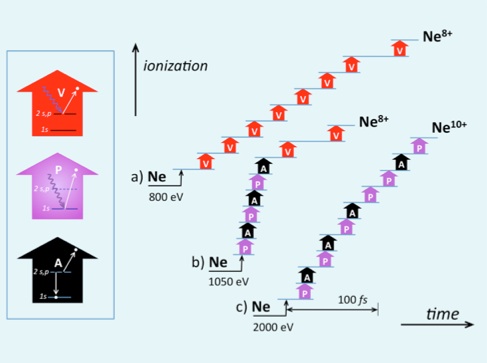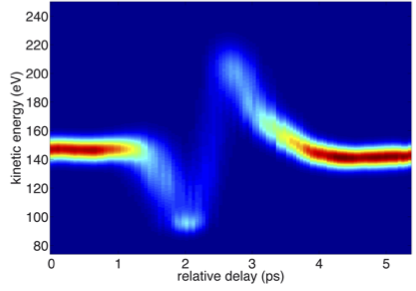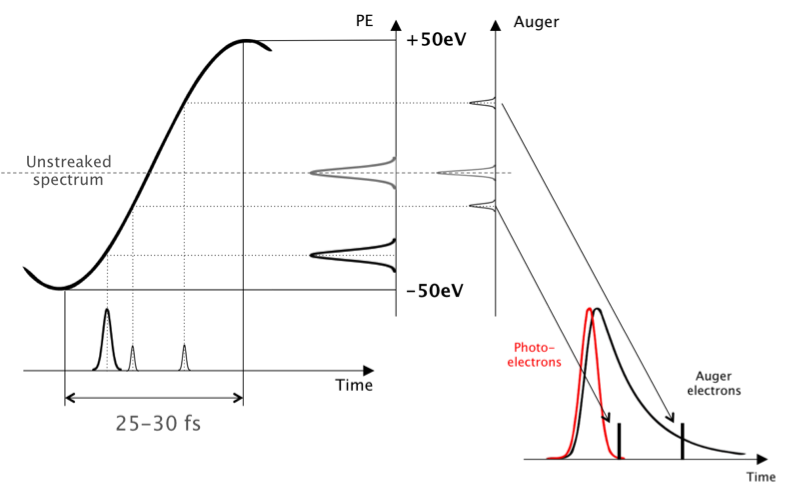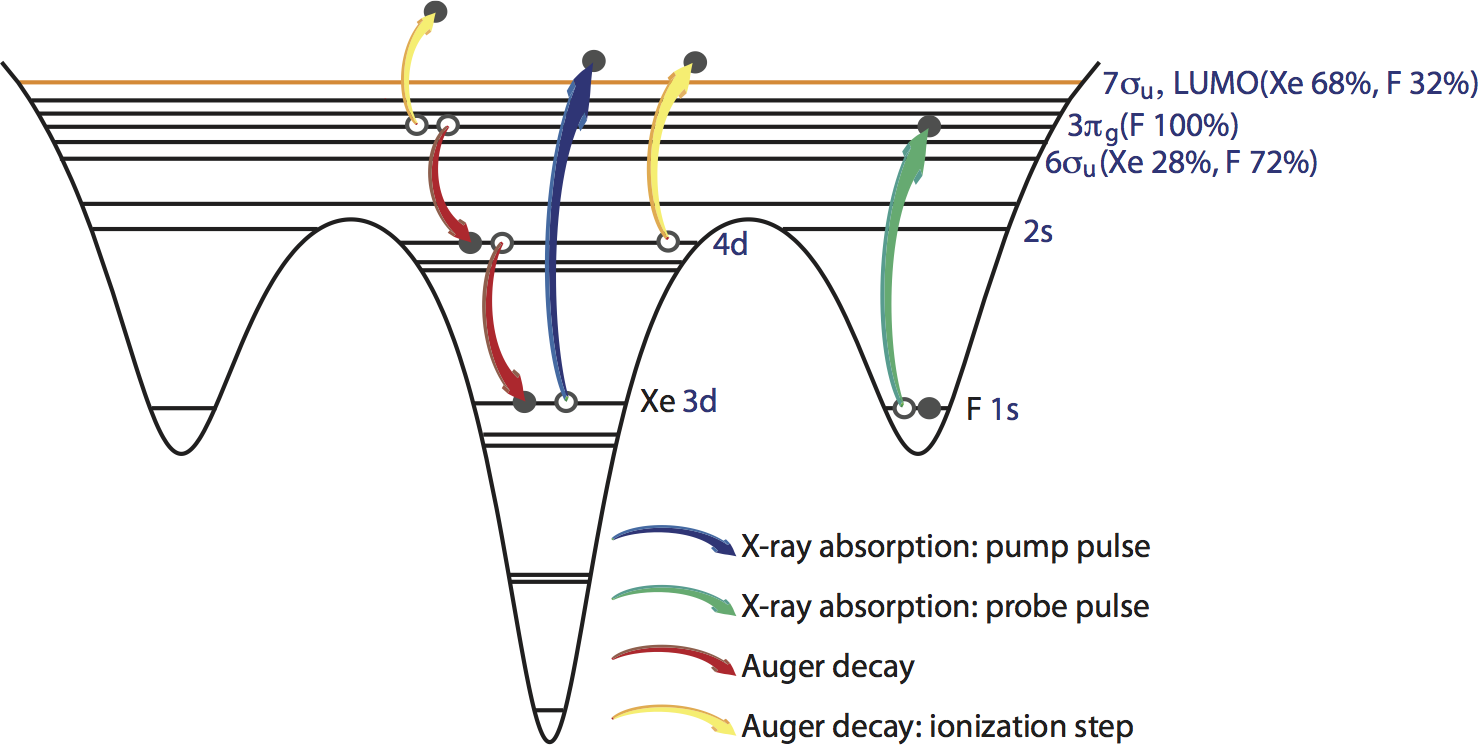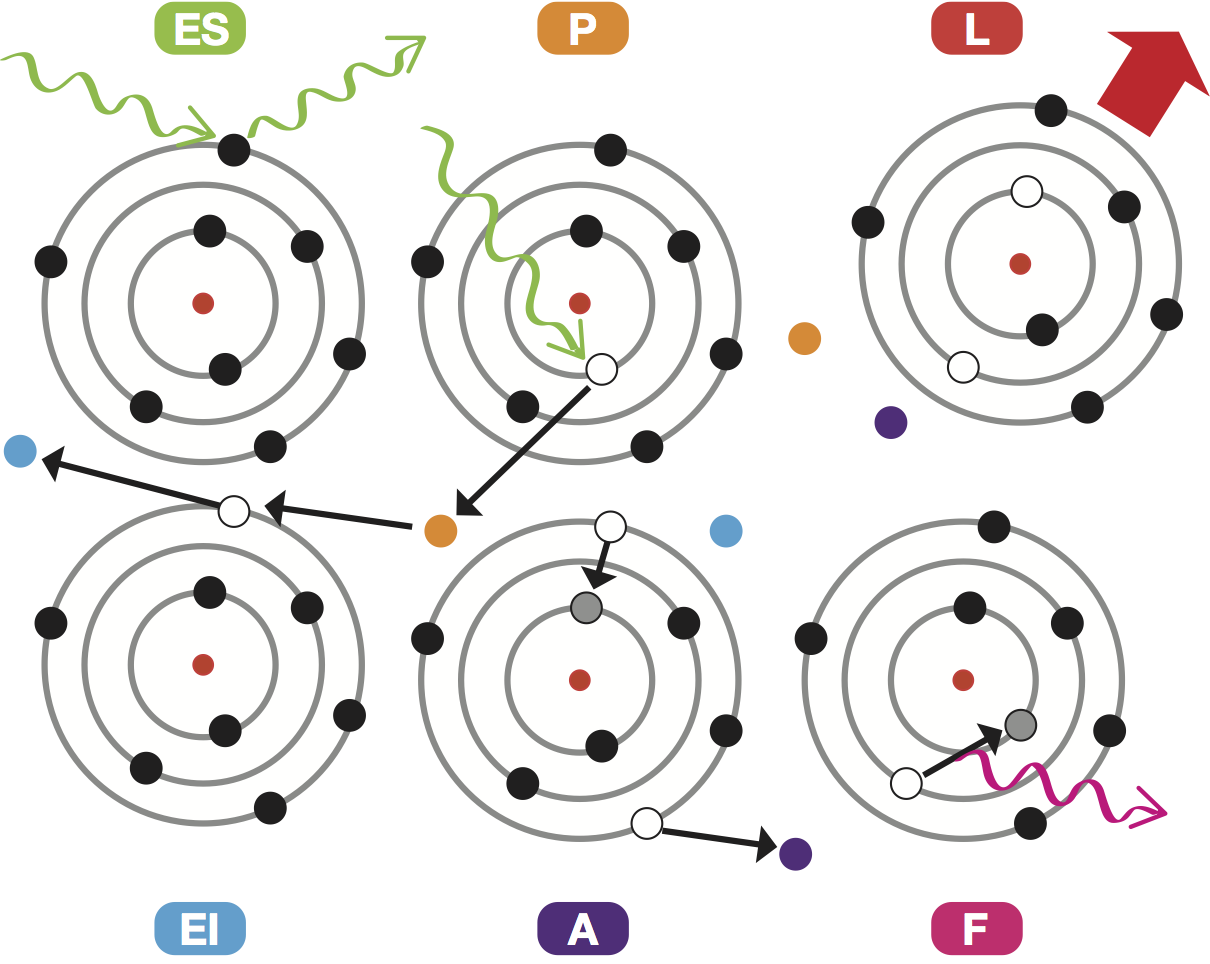| Multiple photon ionization |
|
The AMO group performed some of the first experiments on intense x-ray interactions with atoms and molecules using the LCLS x-ray free-electron laser (XFEL). A dramatic early observation was the stripping of all ten electrons from atomic neon by single LCLS pulses. The process of sequential absorption of six photons and four Auger decays is illustrated in Fig. 2. The experiments also demonstrated efficient hollow-neon production by sequential photoionization of both K-shell electrons prior to Auger decay. In another experiment on atomic neon, a single x-ray pulse first ejected a valence electron and then excited a K-shell electron to the valence hole. This was the first example of using intense x rays to open and excite a ``hidden resonance,'' which is a technique we are exploiting in studies of molecular core-hole decay dynamics. The capabilities of the LCLS and other XFELs are continually improving with increased control of pulse durations, reduced bandwidths and increased coherence by seeding, and schemes to produce two or more pulses with variable delays and colors. Our recent experiments seek to exploit these properties for studies of multiple-photon ionization and core-hole decay dynamics. |
| LCLS pulse duration measurements |
|
The LCLS can produce very intense x-ray pulses believed to be as short as a few femtoseconds, but precise determination of the pulse durations is a research topic in itself. Any measuring scheme is rendered even more challenging by the operating mode of LCLS, called SASE (Self Amplified Spontaneous Emission), which makes it a purely chaotic source and ultimately requires a single shot measurement of every shot to get a full characterization of the source properties. In addition, the SASE operation produces an inherent temporal jitter between the x-ray pulses and any other laser source operating in parallel, which limits greatly the resolution of pump-probe techniques commonly used in time-resolved measurements.
The main route followed by our collaboration to get a handle on those temporal properties consists in transferring the time properties of the x-ray pulses to electron wave-packets produced during ionization or subsequent Auger decay of a gas target. The simultaneous presence of a strong laser field (operating in the visible, IR or THz region) modifies the energy spectrum of those electron wave-packets in a deterministic way, as shown in Fig. 3. The laser field "streaks" the electron energies as a function of the time of emission so that an electron energy measurement encodes time information. |
| Self-referencing time domain measurements of femtosecond inner shell dynamics |
|
The availability of ultrashort x-ray laser pulses opens the potential of following ultrafast electronic and nuclear movements with atomic resolution. However, the timing jitter between the x-ray pulses and any external source can dominate the temporal resolution of the measurements. We propose a potentially very general technique to overcome this limitation when the observables are electrons (either photoelectrons or Auger electrons), by extending the laser streaking technique to measure simultaneously both the timing of direct photoionization from the x-ray pulse and the time dependent feature of interest. The concept is illustrated in Fig. 4.
Measuring the photoionization event allows one to create, on a shot by shot basis, an absolute reference for the timeline of events being triggered by that pulse. Because this timing is extracted for every shot, events with low statistics can then be correctly added up to yield high quality data in the time domain. The objective is to measure, for every shot, the streaked energy spectra of both the photoelectron and the other electrons of interest. A streaked photoelectron spectrum collected with good statistics allows determining, for a particular shot, the relative position inside the streaking ramp. Then, determining the amount of streaking experienced by the other electrons that are detected can directly indicate their emission time inside the ramp and relative to the x-ray pulse. |
| Hetero-site-specific femtosecond-time-resolved dynamics |
| Core-hole decay in molecules is a fundamental process far less understood than in isolated atoms. When an x-ray photon is absorbed by a molecule, a core-shell electron can be promoted to an unoccupied valence orbital or to the continuum, leaving a core-hole in the molecule. The core-hole decay will trigger a cascade of processes all occurring at the same time: Auger electron emission, fluorescence photon emission, dissociation/fragmentation of the ion/neutral molecule, energy transfer, and charge transfer. This complex process occurs on the femtosecond time scale. We have developed an experimental approach to follow the intermediate hole-state dynamics by using the capability at the LCLS to generate two femtosecond x-ray pulses of different photon energies with variable time delay. Figure 5 illustrates the two-pulse method for the case of XeF2, a molecule we have studied using x-ray/ion coincidence spectroscopy at the APS. The first x-ray pulse initiates a vacancy cascade by ejecting a Xe 3d electron. After a controlled delay, the second pulse resonantly excites a F 1s electron, i.e., to a hidden resonance. Corresponding theoretical work is in progress to simulate the core-hole excitation and decay transitions. |
| Radiation damage in nanoparticles by intense x-ray interactions |
|
Intense, femtosecond XFEL pulses have been shown to be useful for serial crystallography, imaging biomolecular crystals of sub-micron dimensions. However, radiation damage induced by high intensity x-ray radiation in these crystals is unavoidable. In particular, x-ray photoionization, inner-shell transitions (Auger and fluorescence) and secondary ionization can take place with high probability within the pulse duration, and these processes can damage the structure of the molecules and potentially limit the usefulness of XFELs for molecular structural determination. We devised a theoretical model to investigate the fundamental mechanisms of the damage in clusters of varying size, with an ultimate aim of understanding phenomena from molecular to the nanometer scale, perhaps eventually approaching 1 MDa in size.
In order to obtain an atomistic view of the dynamical x-ray damage processes and the subsequent structural distortion on the target system throughout the x-ray pulse, we use a combined Monte-Carlo/Molecular-dynamics (MC/MD) computational model (see Fig. 6). The rates of all inner-shell transitions and the cross sections of photoionization of each subshell are obtained with Hartree-Fock-Slater calculations. During the x-ray pulse, the occurrences of the photoionization, inner-shell decay processes, electron-impact ionization and the site of their occurrences are treated by Monte-Carlo type methods. Subsequently, the dynamics of the photoelectrons, Auger electrons, secondary electrons and the atoms/ions in the systems are tracked using molecular dynamics methods. The advantage of this MC/MD model is that it allows us to compute the time-dependent coherent x-ray diffraction pattern of the target system by tracking the position of the delocalized electrons and the configuration (electronic configuration and charge state) and positions of atoms/ions. In addition, we can monitor the fluorescence spectrum, charge-state distribution, energy spectra, lattice dynamics, and dynamics of photoelectrons, Auger and secondary electrons. |

